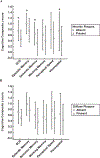Neuritic and Diffuse Plaque Associations with Memory in Non-Cognitively Impaired Elderly
- PMID: 27540968
- PMCID: PMC6314669
- DOI: 10.3233/JAD-160365
Neuritic and Diffuse Plaque Associations with Memory in Non-Cognitively Impaired Elderly
Abstract
The presence of Alzheimer's disease (AD)-related neuropathology among cognitively normal individuals has been well documented. It has been proposed that these individuals may represent a pre-clinical AD population. Previous studies have demonstrated a negative association between the presence of both amyloid-β (Aβ) plaques and neurofibrillary tangles with ante-mortem cognitive performance, a relationship which is likely influenced by a number of factors including age and APOE ɛ4 carrier status. The present study determined whether the presence of neuritic plaques (NPs) and diffuse plaques (DPs) are associated with performance in a number of cognitive domains after accounting for APOE ɛ4 carrier status and neurofibrillary tangle presence in a cohort of 123 older participants from the Rush Religious Order Study who died with a premortem clinical diagnosis of no cognitive impairment (NCI). After adjusting for age at death, education, gender, Braak stage, and APOE ɛ4 carrier status, the presence of NPs was associated with lower performance in the cognitive domains of Global Cognition (p = 0.002), Episodic Memory (p = 0.03), Semantic Memory (p = 0.009), and Visuospatial performance (p = 0.006), while DPs showed no association with any cognitive domain examined. These results suggest that decreases in cognition in elderly NCI individuals are associated with an increase in NPs and not DPs when age at death, education, gender, APOE ɛ4 status, and Braak stage are taken into consideration.
Keywords: Amyloid-β; Braak stage; cognition; neuropathology; pre-clinical Alzheimer’s disease.
Figures



Similar articles
-
Cortical neuritic plaques and hippocampal neurofibrillary tangles are related to dementia severity in elderly schizophrenia patients.Schizophr Res. 2010 Jan;116(1):90-6. doi: 10.1016/j.schres.2009.10.013. Schizophr Res. 2010. PMID: 19896333 Free PMC article.
-
Braak stage and trajectory of cognitive decline in noncognitively impaired elders.Neurobiol Aging. 2016 Jul;43:101-10. doi: 10.1016/j.neurobiolaging.2016.03.003. Epub 2016 Mar 10. Neurobiol Aging. 2016. PMID: 27255819 Free PMC article.
-
Association of Cortical β-Amyloid Protein in the Absence of Insoluble Deposits With Alzheimer Disease.JAMA Neurol. 2019 Jul 1;76(7):818-826. doi: 10.1001/jamaneurol.2019.0834. JAMA Neurol. 2019. PMID: 31009033 Free PMC article.
-
Neuropathology of Alzheimer's disease: a critical update.J Neural Transm Suppl. 1998;54:77-95. doi: 10.1007/978-3-7091-7508-8_8. J Neural Transm Suppl. 1998. PMID: 9850917 Review.
-
Neuropathology and cognitive impairment in Alzheimer disease: a complex but coherent relationship.J Neuropathol Exp Neurol. 2009 Jan;68(1):1-14. doi: 10.1097/NEN.0b013e3181919a48. J Neuropathol Exp Neurol. 2009. PMID: 19104448 Free PMC article. Review.
Cited by
-
Neuritic Plaques - Gateways to Understanding Alzheimer's Disease.Mol Neurobiol. 2024 May;61(5):2808-2821. doi: 10.1007/s12035-023-03736-7. Epub 2023 Nov 8. Mol Neurobiol. 2024. PMID: 37940777 Free PMC article. Review.
-
Transformation of non-neuritic into neuritic plaques during AD progression drives cortical spread of tau pathology via regenerative failure.Acta Neuropathol Commun. 2023 Dec 1;11(1):190. doi: 10.1186/s40478-023-01688-6. Acta Neuropathol Commun. 2023. PMID: 38037144 Free PMC article.
-
Left frontal connectivity attenuates the adverse effect of entorhinal tau pathology on memory.Neurology. 2019 Jul 23;93(4):e347-e357. doi: 10.1212/WNL.0000000000007822. Epub 2019 Jun 24. Neurology. 2019. PMID: 31235661 Free PMC article.
-
Anti-amyloidogenic indolizino[3,2-c]quinolines as imaging probes differentiating dense-core, diffuse, and coronal plaques of amyloid-β.RSC Med Chem. 2021 Oct 11;12(11):1926-1934. doi: 10.1039/d1md00030f. eCollection 2021 Nov 17. RSC Med Chem. 2021. PMID: 34825188 Free PMC article.
-
The fluorescent ligand bTVBT2 reveals increased p-tau uptake by retinal microglia in Alzheimer's disease patients and AppNL-F/NL-F mice.Alzheimers Res Ther. 2024 Jan 2;16(1):4. doi: 10.1186/s13195-023-01375-7. Alzheimers Res Ther. 2024. PMID: 38167557 Free PMC article.
References
-
- Tomlinson BE, Blessed G, Roth M (1968) Observations on the brains of non-demented old people. J Neurol Sci 7, 331–356. - PubMed
-
- Bennett DA, Schneider JA, Arvanitakis Z, Kelly JF, Aggarwal NT, Shah RC, Wilson RS (2006) Neuropathology of older persons without cognitive impairment from two community-based studies. Neurology 66, 1837–1844. - PubMed
-
- Dickson DW, Crystal HA, Mattiace LA, Masur DM, Blau AD, Davies P, Yen SH, Aronson MK (1992) Identification of normal and pathological aging in prospectively studied nondemented elderly humans. Neurobiol Aging 13, 179–189. - PubMed
-
- Morris JC, Storandt M, McKeel DW Jr, Rubin EH, Price JL, Grant EA, Berg L (1996) Cerebral amyloid deposition and diffuse plaques in “normal” aging: Evidence for presympomatic and very mild Alzheimer’s disease. Neurology 46, 707–719. - PubMed
Publication types
MeSH terms
Substances
Grants and funding
LinkOut - more resources
Full Text Sources
Other Literature Sources
Medical
Molecular Biology Databases
Miscellaneous

